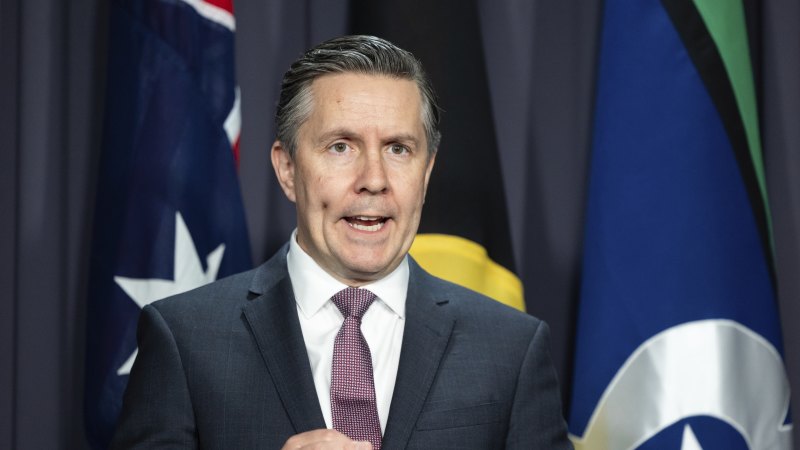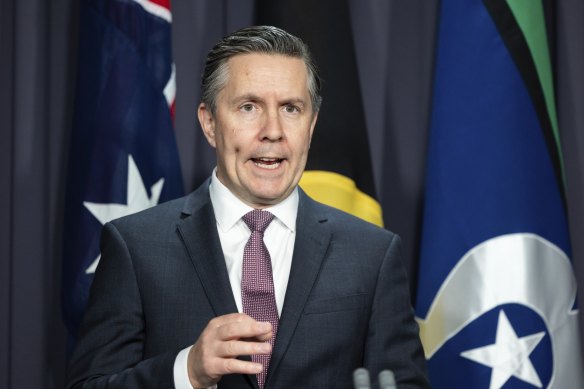Will Australia follow England and ban smoking for the next generation?

Save articles for later
Add articles to your saved list and come back to them any time.
British Prime Minister Rishi Sunak this week declared England would follow New Zealand’s path on tobacco control and in effect ban cigarettes for the next generation.
Australian Health Minister Mark Butler – who has been talking for months about making the country a world leader in tobacco control again – says he will closely monitor the policies’ progress overseas. But he has no plans to follow suit.
Health Minister Mark Butler has tabled his own legislation aimed at bringing down the Australian smoking rate – but there’s no lifetime ban.Credit: Alex Ellinghausen
What countries will ban smoking?
Under Sunak’s plan, which he will put to parliament before next year’s general election, the age at which people can buy cigarettes and tobacco in England, which is currently 18, would rise by a year every year, starting in 2027.
This means a child aged 14 today could never legally buy tobacco. By 2040, only those above the age of 35 would be able to make such purchases legally.
It mirrors laws that came into effect in New Zealand this year that stop tobacco being sold to anyone born on or after January 1, 2009. The ban remains in place for a person’s whole life and breaches by retailers are punishable by fines of up to $NZ150,000 ($140,109).
Will smoking be banned in Australia?
Butler has tabled his own legislation aimed at bringing down the Australian smoking rate – but there’s no lifetime ban.
“The UK and New Zealand have responded to the specific tactics of big tobacco marketed to their populations, and we will monitor their implementation success with interest,” Butler said on Thursday, when asked if Australia could follow their path.
“In the Australian context, we have assessed all of those best-practice measures, and they are now incorporated into legislation which has been the subject of substantial exposure and consultation.”
Under the new laws, there will be individual warning labels on each cigarette – for example, a slogan that says “smoking kills” – an idea pioneered by Canada.
Australia will also standardise the size of tobacco products, so there is less to differentiate them. This includes eliminating skinny “vogue” cigarettes and banning menthols. The names tobacco companies can use – such as “fresh burst” – will be limited, while health pamphlets will come with each pack. On top of this, there will be a 5 per cent price hike each year for three years.
Why are similar countries taking different approaches?
England, New Zealand, Canada and Australia are each aiming for a “smoke-free” society – which means a population smoking rate of 5 per cent or less. But despite similarities between the four nations, they are working in unique contexts.
First, they have different deadlines. New Zealand wants to hit that milestone by 2025; England wants to be smoke-free by 2030; and Canada has set a target of 2035. Australia wants to achieve a daily smoking rate of less than 10 per cent by 2025, and less than 5 per cent by 2030.
Second, they have different starting points.
In New Zealand, the percentage of adults who smoked daily in 2021-22 was 8 per cent, while in Canada, the daily smoking rate for all Canadians, aged 15 and over, was 8.2 per cent in 2022.
The United Kingdom has higher smoking rates: 12.9 per cent of adults smoked in 2022. Australia sits in between. One in 10 adults (10.1 per cent) were daily smokers in 2021-22, according to the Australian Bureau of Statistics.
What about vaping?
Each country has also adopted different vaping policies, with varying results.
In New Zealand and Canada, where smoking rates are lower, vaping rates are higher. New Zealand has the highest youth vaping rates among the four countries, with 22.9 per cent of 18 to 24-year-olds saying they vape daily. In Canada, 20 per cent of 20 to 24-year-olds vaped at least once in the past 30 days.
In the UK, 15.5 per cent of 16 to 24-year-olds were daily or occasional vapers in 2022. Data collected by NSW Health, which has the most up-to-date vaping statistics in Australia, suggests 16.5 per cent of young people in that age group vaped either daily or occasionally in 2021 and 2022.
Australia is the only country that will totally outlaw recreational vaping and restrict it to people with a doctor’s prescription, in an attempt to quash a flourishing black market. Elsewhere, vapes are available to purchase like cigarettes, with differing restrictions on nicotine concentration.
However, New Zealand and the UK could follow Australia’s lead by banning disposable vapes and restricting flavours and colours.
What do the experts think?
The chair of the Cancer Council’s tobacco issues committee, Alecia Brooks, said Sunak’s announcement was encouraging but was unlikely to have an impact on England’s smoking rates for several years.
“Australia faces different circumstances. We have a window of opportunity to act, earlier than the UK did, before a new generation develops a lifelong nicotine addiction,” she said.
She said Butler’s tobacco and vaping reforms would complement each other in this specific context. “Cancer Council’s priority is to continue to progress the tobacco laws and vaping measures recently announced by the federal government,” she said.
Professor Simon Chapman, a tobacco control activist, said youth smoking bans were an interesting policy that could have momentum.
While New Zealand was the first to action it, the idea had been floated in Singapore and even Tasmania.
“Like with a lot of these things, there are vanguard countries which do it and others follow,” he said.
Canada was the first country to introduce graphic warnings in 2000 and Australia paved the way for plain packaging in 2012 – measures now in place in many countries around the world.
But Chapman said England was playing “catch-up” for its relatively higher smoking rates and he did not expect the policy in Australia any time soon.
“I’d welcome it, but the last thing I’d want to see is the brakes on what we’re [already] doing. I think it’s something that can be [looked at] in the next round of reforms,” he said.
”It ought to be examined down the track and, in a couple of years time, we’ll probably have data from New Zealand, although not from the UK.”
Chapman said he expected some challenges implementing the youth bans, although they would be mitigated by the advent of electronic identification.
“Many of the practical objections are probably easily surmountable,” he said.
Cut through the noise of federal politics with news, views and expert analysis. Subscribers can sign up to our weekly Inside Politics newsletter.
Most Viewed in Politics
From our partners
Source: Read Full Article
